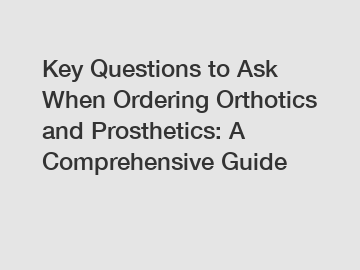Four Prong Prosthetic Legs: Top FAQs Answered!
Prosthetic legs have evolved significantly over the years, transforming countless lives and providing mobility to those who need it most. Among the various types of prosthetic options available, four prong prosthetic legs have gained attention for their innovative design and efficiency. In this blog, we’ll explore the most frequently asked questions about four prong prosthetic legs, drawing from expert insights and user experiences.
What are Four Prong Prosthetic Legs?
Four prong prosthetic legs are designed with four contact points with the ground, as opposed to traditional prosthetics that may have one or two. This unique configuration enhances stability and balance, crucial for users who need reliable mobility. The four prongs allow for a broader weight distribution, enabling more natural movement, which can be particularly beneficial for active individuals.
Who Can Benefit from Four Prong Prosthetic Legs?
These prosthetic legs are most beneficial for individuals with lower leg amputations, whether due to trauma, disease, or congenital disorders. Athletes, active individuals, and even those who prefer a leisurely lifestyle can benefit from the enhanced stability and support. Furthermore, their design can be advantageous for those who struggle with balance, giving them the confidence to regain their independence.
How Do Four Prong Prosthetic Legs Differ from Traditional Prosthetics?
The primary difference lies in their design and functionality. Traditional prosthetic legs typically rely on one or two points of contact, which can make balance challenging, especially on uneven surfaces. Conversely, the four prong design distributes weight more effectively, allowing for better shock absorption and stability. This can lead to improved gait mechanics, making it easier for users to walk, run, or engage in various physical activities.
Are Four Prong Prosthetic Legs More Expensive?
Cost is always a consideration when looking into prosthetic options. Generally, four prong prosthetic legs can be more expensive than traditional models due to their advanced design and materials used. However, the value they provide in terms of mobility, comfort, and overall quality of life often outweighs the initial investment. It’s essential to check with insurance providers, as many plans may cover a portion of the costs, especially if proven necessary for the user’s quality of life.
How Do I Choose the Right Four Prong Prosthetic Leg?
Choosing the right prosthetic leg is a highly personalized decision. It's crucial to work closely with a certified prosthetist who can assess individual needs and lifestyle. Considerations such as height, weight, activity level, and even personal preferences play significant roles in the selection process. A prosthetist will often conduct a thorough evaluation to recommend the best option tailored specifically to you.
Additional resources:How to Choose a Four Prong Prosthetic Leg?
Are Four Prong Prosthetic Legs Suitable for Sports?
Top 5 Crank Beds for Nursing: Comfort and Convenience in Care
Top Metal Titanium Clip Trends to Watch in 2024
Suppliers Wholesale High Quality Rapid Arterial Hemostasis Product Type
Revolutionizing Eye Care: Benefits of Non Mydriatic Cameras
Choosing the Right Moveable Bed for Patients’ Comfort
What Is SMAS HIFU and How Does It Work?
Absolutely! Many users of four prong prosthetic legs report enhanced performance in sports. Their design allows for better balance and stability, which is critical in various athletic activities. Whether it’s running, hiking, or participating in team sports, these prosthetics can provide the support and confidence athletes need to excel. There are even specialized versions designed specifically for competitive sports, making it easier for athletes to push their limits.
What Maintenance is Required for Four Prong Prosthetic Legs?
Regular maintenance is essential to ensure the longevity and functionality of any prosthetic limb, including four prong legs. Users should clean their prosthetic regularly to prevent dirt and debris buildup. It’s also advisable to have the device inspected periodically by a professional to check for wear and tear, ensuring everything is functioning optimally. Staying attentive to these aspects can help to prevent any unnecessary issues down the line.
What Do Users Say About Their Experience with Four Prong Prosthetic Legs?
User reviews and testimonials speak volumes about the effectiveness of four prong prosthetic legs. Many individuals express a newfound sense of freedom and confidence in their mobility. The extra stability allowed them to engage more with their families, participate in activities they once avoided, and enjoy life without the constant fear of losing balance. The community of users often shares encouragement and tips, creating a supportive network for new users.
What Should I Expect Going Forward with a Four Prong Prosthetic Leg?
Adjusting to a new prosthetic can take time, but with persistence and the right support, most users find their stride. Expect some learning curves initially, with potential discomfort as the body adapts. However, most report a seamless transition after appropriate fitting and adjustments. Staying active and committed to rehabilitation exercises can greatly enhance the experience of using a four prong prosthetic leg, leading to improved mobility and independence.
In conclusion, four prong prosthetic legs offer a significant advancement in mobility solutions for individuals with lower limb amputations. Their design emphasizes stability, balance, and user comfort, making them an ideal choice for many. By understanding their benefits, costs, and maintenance, users can make informed choices that enhance their quality of life and restore their mobility with confidence.
Want more information on prosthetic leg Four Prong, prosthetic foot supplier, Sach Foot Adaptor? Feel free to contact us.
Additional resources:How Can Custom Prosthetics Enhance Comfort and Mobility?
How Can High Ankle Carbon Fiber Improve Your Comfort and Mobility?
Essential Guide to Using Manual Hospital Beds
How to Choose the Right Anesthesia Trolley?
Understanding Digital Slit Lamps: Key Features and Benefits
How Does What Are Eco-Friendly Packaging Materials Made of Work?
Top Skin Testing Machines to Watch in 2025









